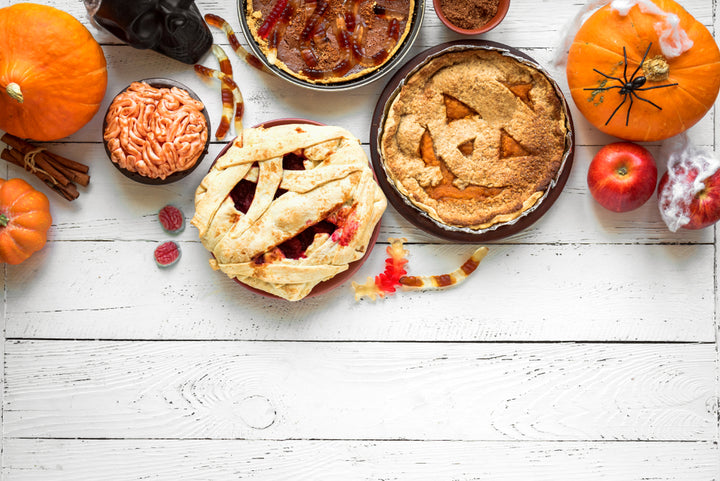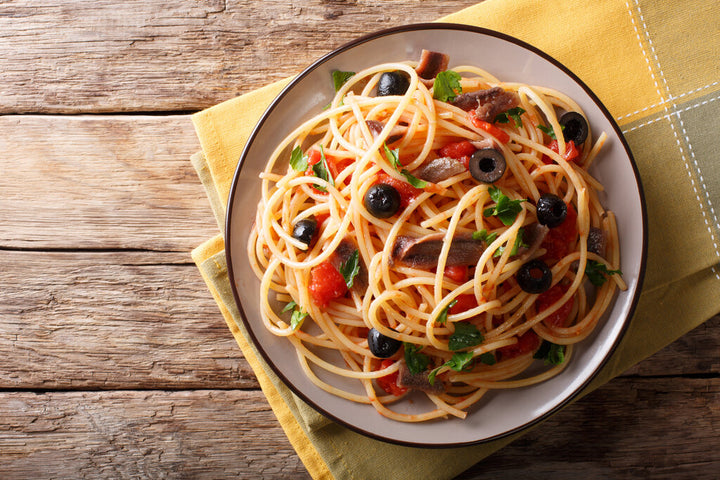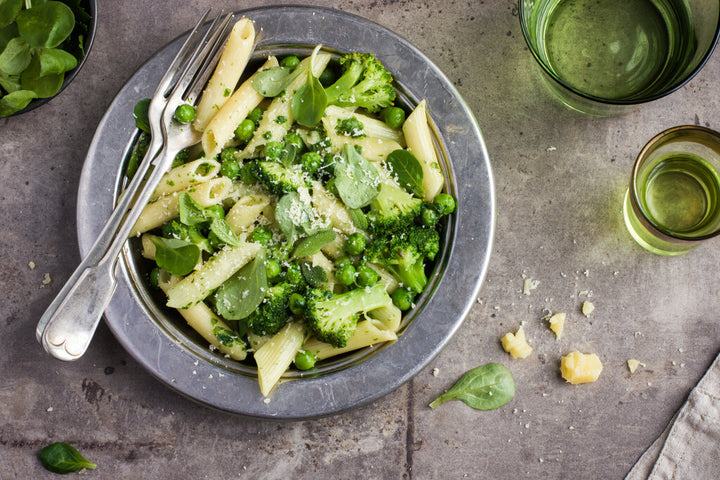If you're a vegan, and a regular visitor to Thai restaurants, you've probably been disappointed to learn that one of the signature dishes in Thai cuisine is not vegan since it contains fish sauce, eggs, and dried shrimp. Well, luckily for you, we've worked out a way to make pad Thai vegan friendly at last. We've switched out the fish sauce for soy, and used tofu (pad Thai is typically made with shrimp, or sometimes even chicken).
Vegan Thai food is becoming more and more popular, and what better way to start learning how to cook vegan Thai recipes than with this classic - a vegan pad Thai. The only cookware you'll need is a saucepan for the noodles and a steel or cast iron wok for the main dish. After you try this vegan pad Thai recipe once, it is sure to become one of your easy go-to recipes.
Vegan Pad Thai FAQs
How can I turn this recipe into Vegetarian Pad Thai?
If you want to create a vegetarian version of this recipe you can add an egg to the recipe, to bring it closer to the classic version.
- To do this, follow the instructions given above for vegan pad Thai, and after you've cooked the tofu, but before adding the noodles, push the fried tofu to one side and add a beaten egg to the wok, using your wooden spoon or spatula to scramble it quickly.
- Once the egg has formed small chunks, continue with the rest of the instructions for vegan pad Thai.
Voila! A perfect vegetarian pad Thai!
For a spicier vegetarian or vegan pad Thai, try adding some fresh chopped chili or top with sriracha sauce before serving.
What sort of tofu should I use?
Tofu is traditionally characterized within three forms - soft, firm, and extra-firm. We would recommend the extra firm variety, as using it will ensure that it does not stick to the bottom of the pan and takes less time to press (more on that below). This will make cooking the whole dish much easier, although it does not sauté as well as softer tofu.
Does my tofu need to be pressed before cooking?
You do need to use a tofu press to remove any excess water for the softer types of tofu. But even if you are using extra-firm tofu you should still press it for around 15 to 30 min to ensure that all the water is completely removed.
Removing all the water will make it easier to make your tofu crispy!
How can I tell when tofu is fully cooked?
When the tofu is cooked, it should be equally crispy on both sides if you turn it over frequently, as suggested in the opening step.
While cooking the tofu you should turn it over frequently to ensure that it does not stick to the bottom of the pan, as explained in the recipe above. If you are using a cast-iron wok, the tofu is less likely to stick, as the cast iron has a naturally non-stick surface.
What type of noodles are best for pad Thai?
You will most commonly see pad Thai served with different types of rice noodles, like dried flat rice noodles. These types of noodles are made by combining rice flour and water, and are relatively transparent and quite easily broken.
You need to be careful not to overcook these noodles because they can turn soggy and lose some of their taste.
You can, however, substitute other types of noodles into your vegan pad Thai, although the same principles of cooking still apply. Soba noodles contain similar ingredients to their rice counterparts but are made using buckwheat flour instead of rice flour. If you opt to create a vegetarian pad Thai, you can also substitute in egg noodles, which are rich in flavor.
Can I reheat pad Thai?
Yes, you can. If have you made enough pad Thai for more than one sitting, you can eat some and then easily reheat the rest at a later time.
If you are heating in a wok or pan, you will need to warm a small amount of oil in a pan on medium heat before beginning to reheat the pad Thai. Again, be careful that the noodles do not stick to the pan and ensure that they are not overcooked, whilst sautéing for around 10 min and stirring at frequent intervals.
Can I prepare pad Thai ahead of time?
Yes, although we would recommend following the above instructions when it is time to reheat and serve the dish. To prepare the noodles ahead of time, make sure you soak and drain them before rinsing thoroughly. Then, prepare the pad Thai sauce before covering both and refrigerating until you need to serve.
What alternative vegetables could I use?
Whatever you like! Feel free to use any vegetables you have available.
Peas and soybeans are low in water content but high in protein, whilst you can also add in higher water content vegetables like broccoli and spinach. But just like with our stir fry recipes, if you are using vegetables with multiple textures, you should add the stems first before then adding the leaves.
You could even add red pepper to spice up your vegan pad Thai dish. The high amounts of beta-carotene and vitamins A and C in red peppers also make them a great addition for anyone that is trying to add a few extra micronutrients to their diet. Green and yellow peppers are also suitable alternatives, although they contain less of those vitamins and nutrients.
Can lime be substituted out?
Lime adds a zingy taste to pad Thai, but feel free to substitute in something like a lemon if you don’t have a lime on hand. Lemon zest is more commonly used in baking but can be a nice little pop of flavor pad Thai if you are in a pinch.
Can I use an alternative to green onion?
Yes, of course! Different types of onions do have different properties, though, so we would advise picking the one that best suits your idea of the perfect pad Thai dish.
- Spring onions are both tasty and full of flavor, although they are high in water content so do take longer to cook fully.
- Red onions are typically milder in flavor and tend to be of a larger size as well as being more commonly grilled or lightly cooked.
- Sweet onions are also a worthy option to consider, but they do contain plenty of sugar.
- Leeks are part of the onion family as well and come in many different varieties. Although they offer a milder taste compared to green onions, they are softer and are equally easy to cook, making them ideal to add into this pad Thai dish.
What can I serve alongside pad Thai?
There are many different serving suggestions for your vegan pad Thai. Pad Thai is traditionally eaten as a whole meal without side dishes, but serving with spring rolls is a good option. Of course, you will have to ensure that you source vegan spring rolls, as not all pastry types are vegan and some types of spring roll contain fish sauce.
We have advised topping your pad Thai with peanuts and cilantro, but you can use any other mix of herbs and spices to create your perfect flavor. Dill and chives are commonly used in cooking, whilst basil is one of the most popular forms of herb and also one of the healthiest options too. You could also add some coriander and stir fry it into the mixture – this is a perfect option for vegetarian pad Thai.
Alternatively, you could also prepare a delicious green mango salad. Traditional recipes do tend to include fish sauce, so to keep your dish strictly vegan you should remove any traces of it. The green mango salad can also be prepared in time as well, around a day prior to serving. You can fill crepes or pancakes with pad Thai, although you will need to source a vegan recipe – they are commonly produced with almond milk, caster sugar, baking powder, sea salt and self-raising flour, along with sunflower oil. It is a good idea to keep the pancakes unflavored, to maximise the taste of the pad Thai inside.
How long can I refrigerate pad Thai?
We recommend storing pad Thai in a refrigerator for a maximum of three days after preparation. The sauces quickly lose their firm texture and become soggier, causing the dish to lose its flavor.
Although you can reheat for up to three days, there is a chance that the noodles can become sticky. We suggest eating any leftovers as quickly as possible.
Is vegan pad Thai healthy?
Pad Thai is a relatively healthy option given the high vegetable content within it.
In terms of calorie intake, rice noodles can be high in carbohydrates so you could substitute them out in place of zucchini noodles, without losing any of the great taste.
Is it healthy to stir fry vegetables?
In general, stir-frying is one of the healthiest ways to cook vegetables, as they retain the majority of their nutritional content.
Stir-frying fits all vegetables, but those with higher water content will have to be put into the mixture earlier as they take longer to cook.
Where does pad Thai come from?
Pad Thai originated relatively recently, dating back to the mid-1930s. Rice noodles were introduced to Thailand by China centuries ago, although the dish itself was created by the Thai Prime Minister of the time. It quickly became the national dish of Thailand, since it was cheaper to produce rice noodles than rice during World War II (rice noodles of course being the staple of any pad Thai dish). It is now popular in restaurants across the world, as well as in street food stalls.
Any variety of a pad Thai is a popular dish, and this vegan pad Thai will be no exception. Bursting with crisp flavor and texture, this is a great dish to eat individually or share with others!
If you loved this recipe and are looking for another way to serve up Pad Thai, check out our wok recipes for Vegetable Pad Thai and Shrimp Pad Thai.
Leave a comment
Comments will be approved before showing up.
Also in Recipes










